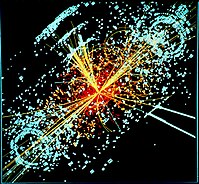
Photo from wikipedia
In this paper, the cosmological model of the Universe has been presented in f(Q)$f(Q)$ gravity and the parameters are constrained from the cosmological data sets. At the beginning, a well… Click to show full abstract
In this paper, the cosmological model of the Universe has been presented in f(Q)$f(Q)$ gravity and the parameters are constrained from the cosmological data sets. At the beginning, a well motivated form of f(Q)=α+βQn$f(Q) = \alpha + \beta Q^{n}$ has been employed, where α, β, and n are model parameters. The Hubble parameter is obtained in redshift with some algebraic manipulation from the considered form of f(Q)$f(Q)$ . Then it is parameterized with the recent Hubble$\text{Hubble}$ data and Pantheon+SHOES$\text{Pantheon} + \text{SHOES}$ data using Markov chain Monte Carlo analysis. The obtained model parameter values are validated with the baryon acoustic oscillation data set. A parametrization of the cosmographic parameters shows the early deceleration and late time acceleration with the transition at zt≈0.75$z_\text{t}\approx 0.75$ . The Om(z)$Om(z)$ diagnostics gives positive slope which shows that the model is in the phantom phase. Also the current age of the Universe has been obtained as, t0=13.85Gyrs$t_{0} = 13.85\nobreakspace \nobreakspace \text{Gyrs}$ . Based on the present analysis, it indicates that the f(Q)$f(Q)$ gravity may provide an alternative to dark energy for addressing the current cosmic acceleration.
Journal Title: Annalen der Physik
Year Published: 2022
Link to full text (if available)
Share on Social Media: Sign Up to like & get
recommendations!